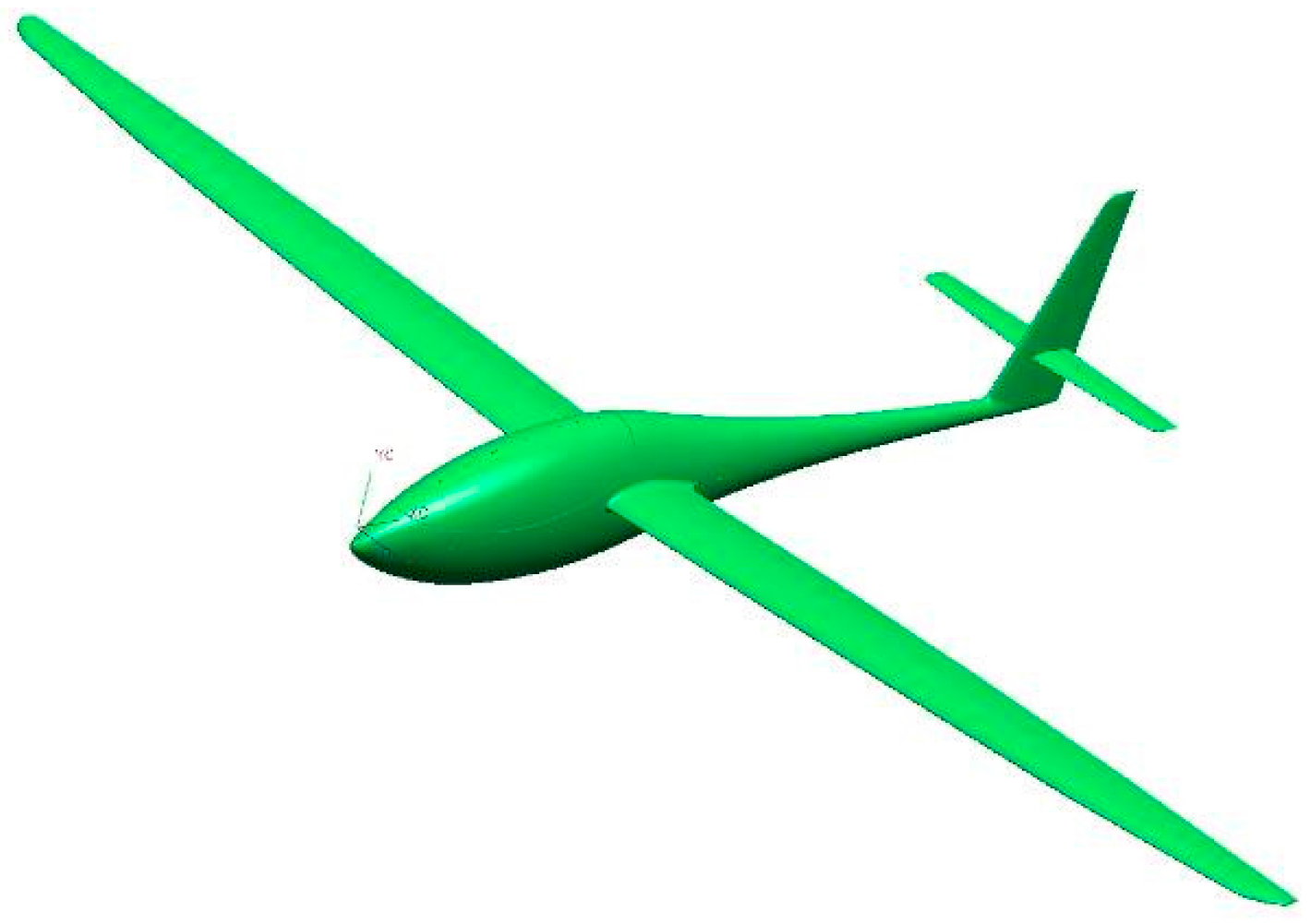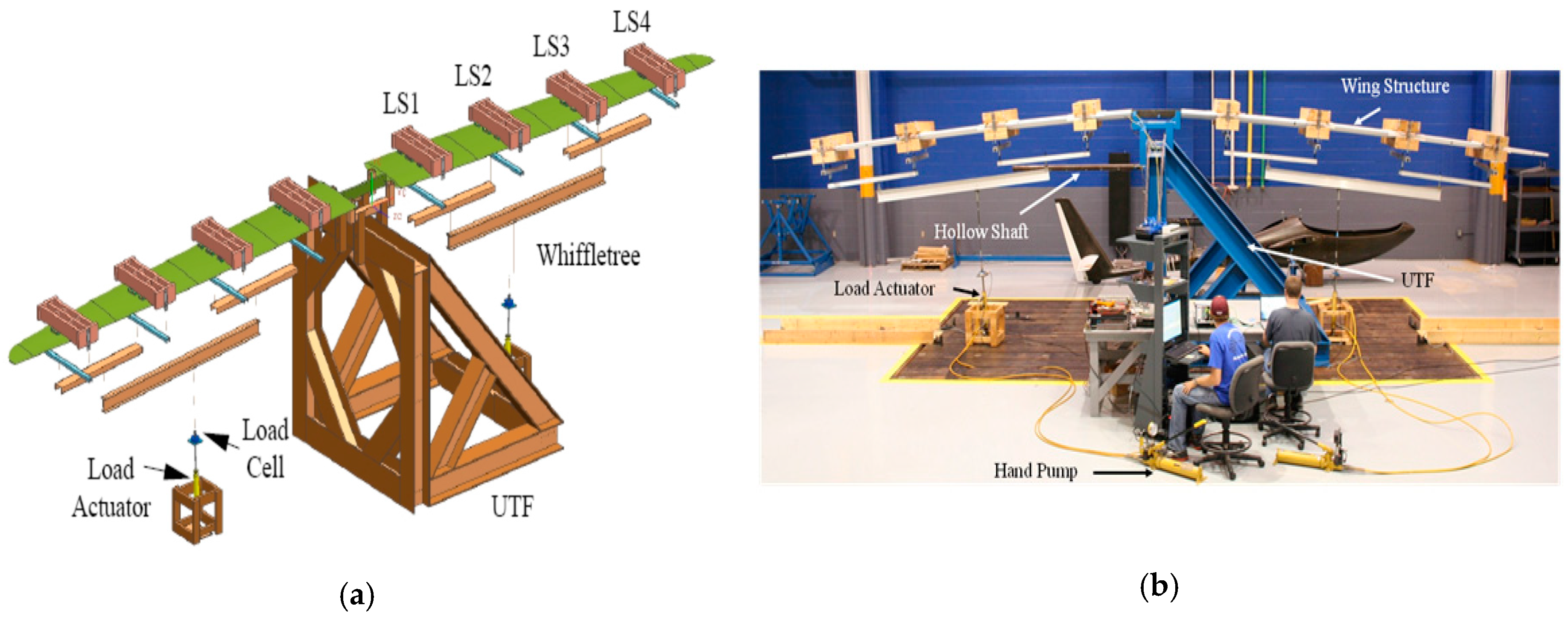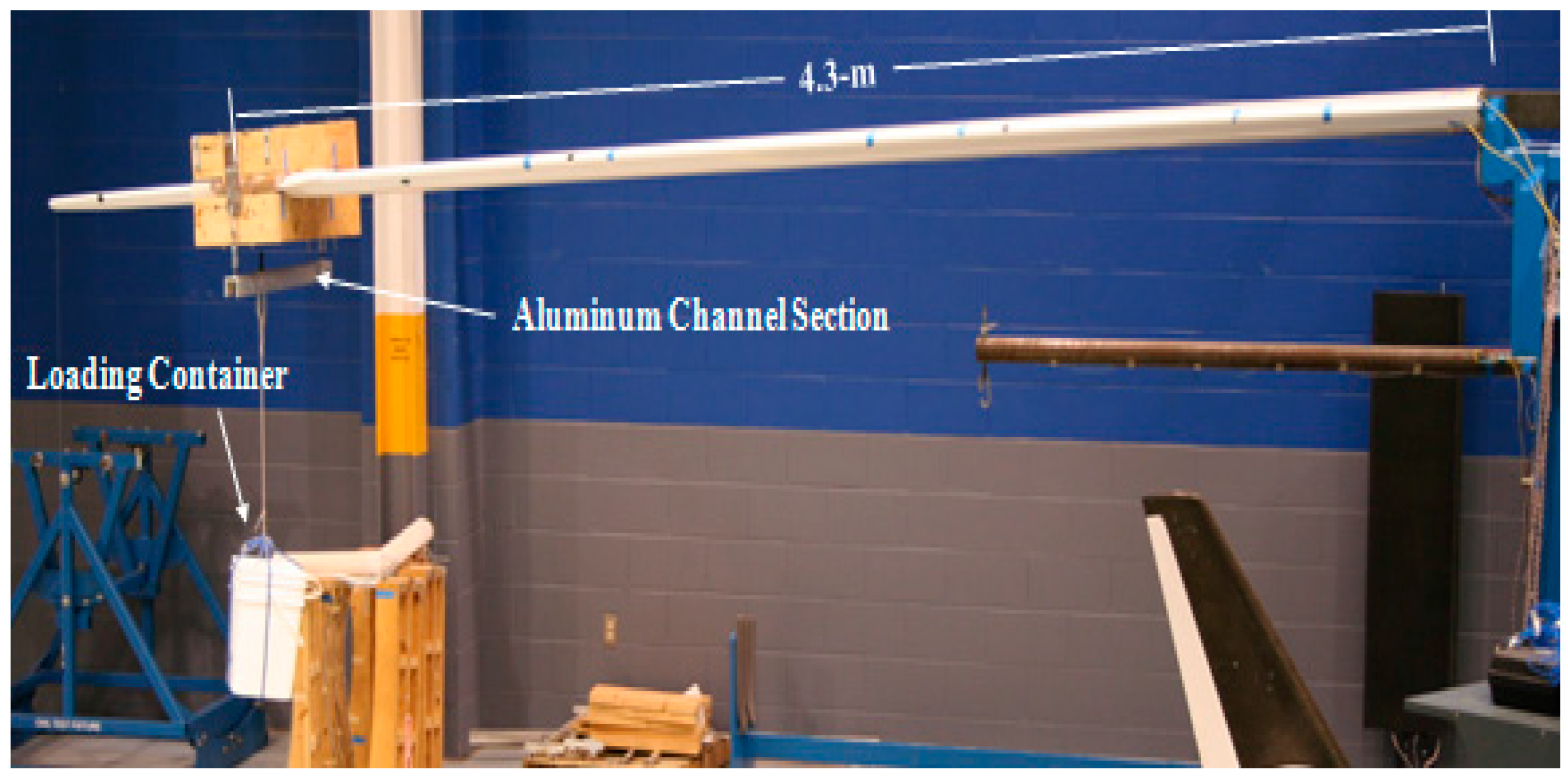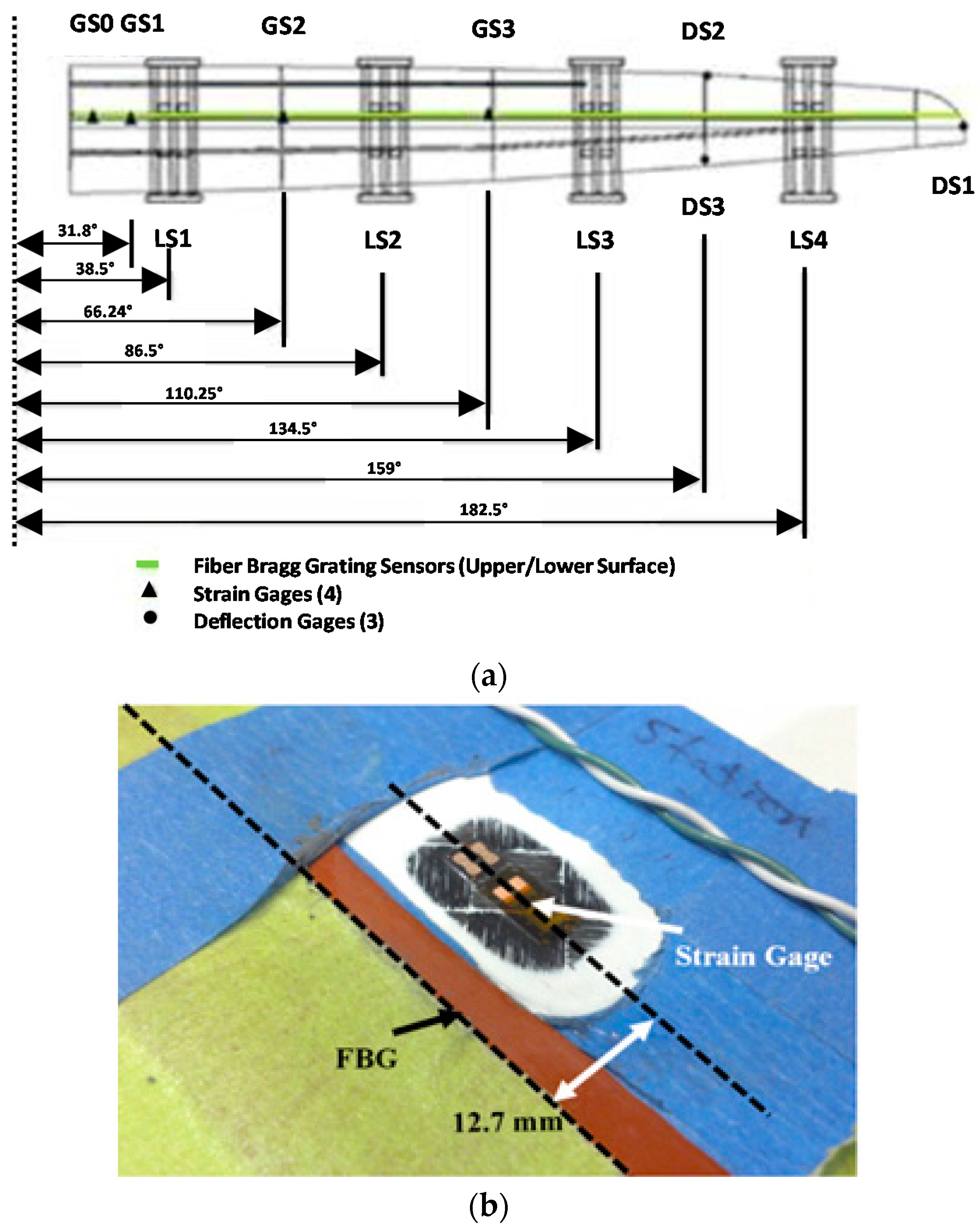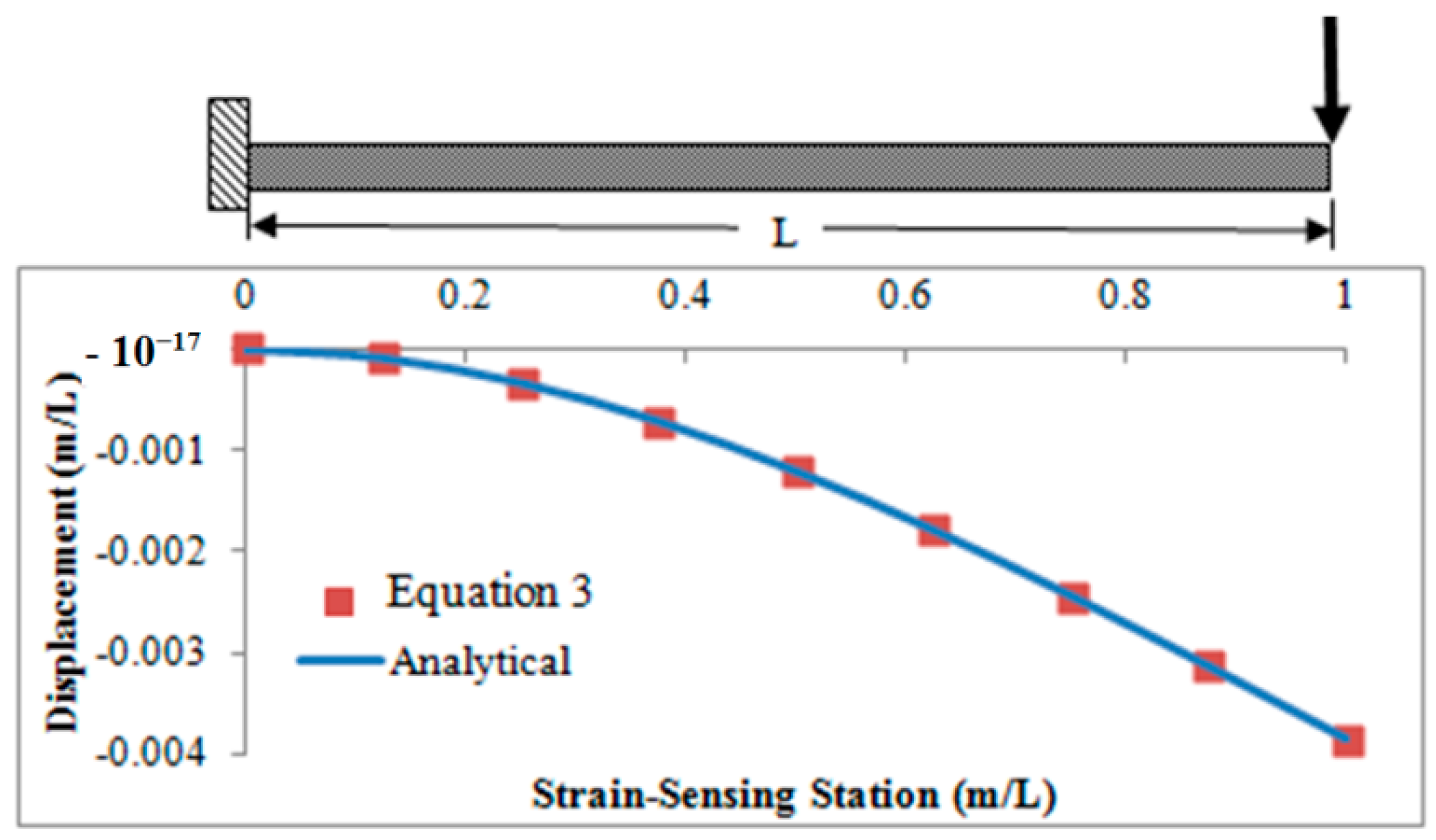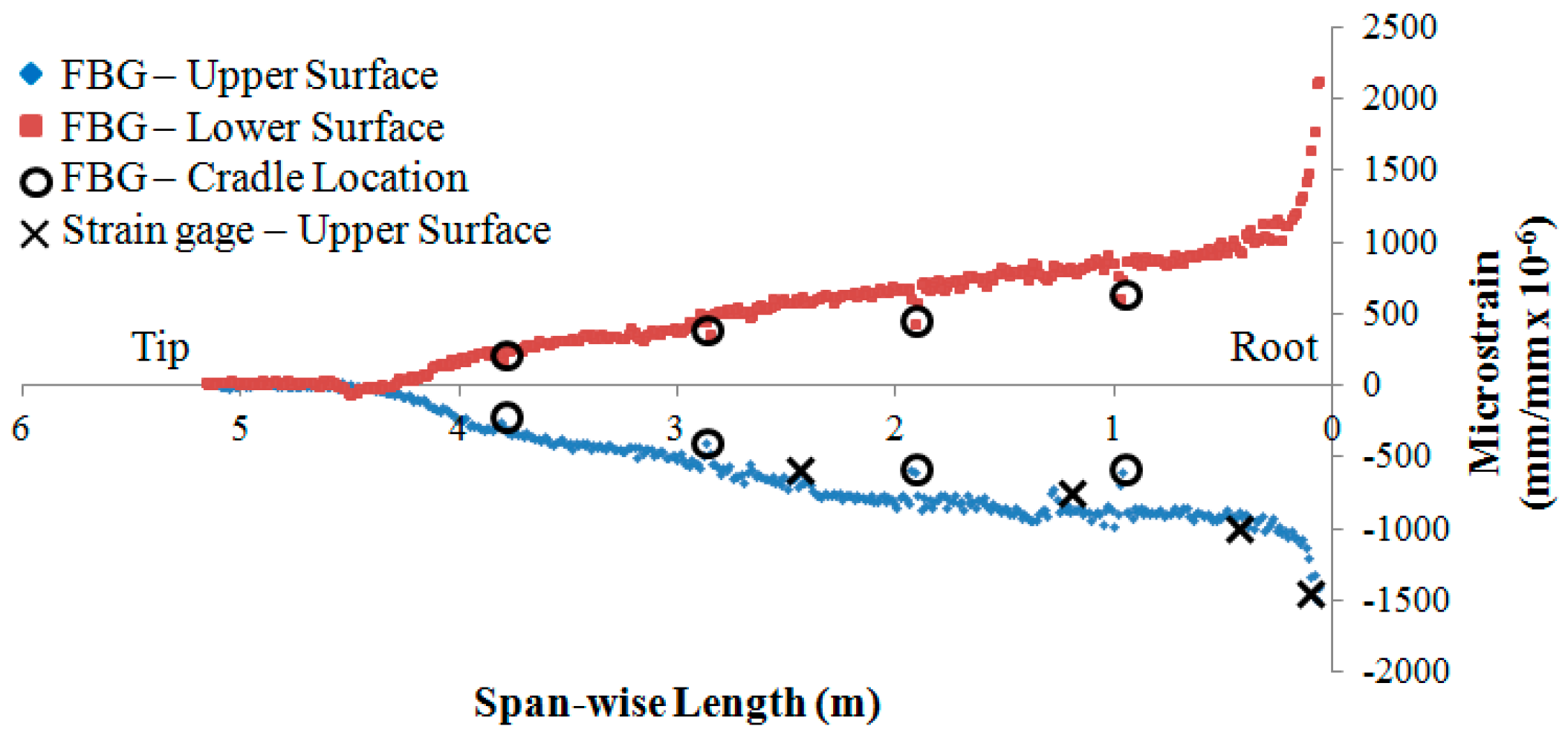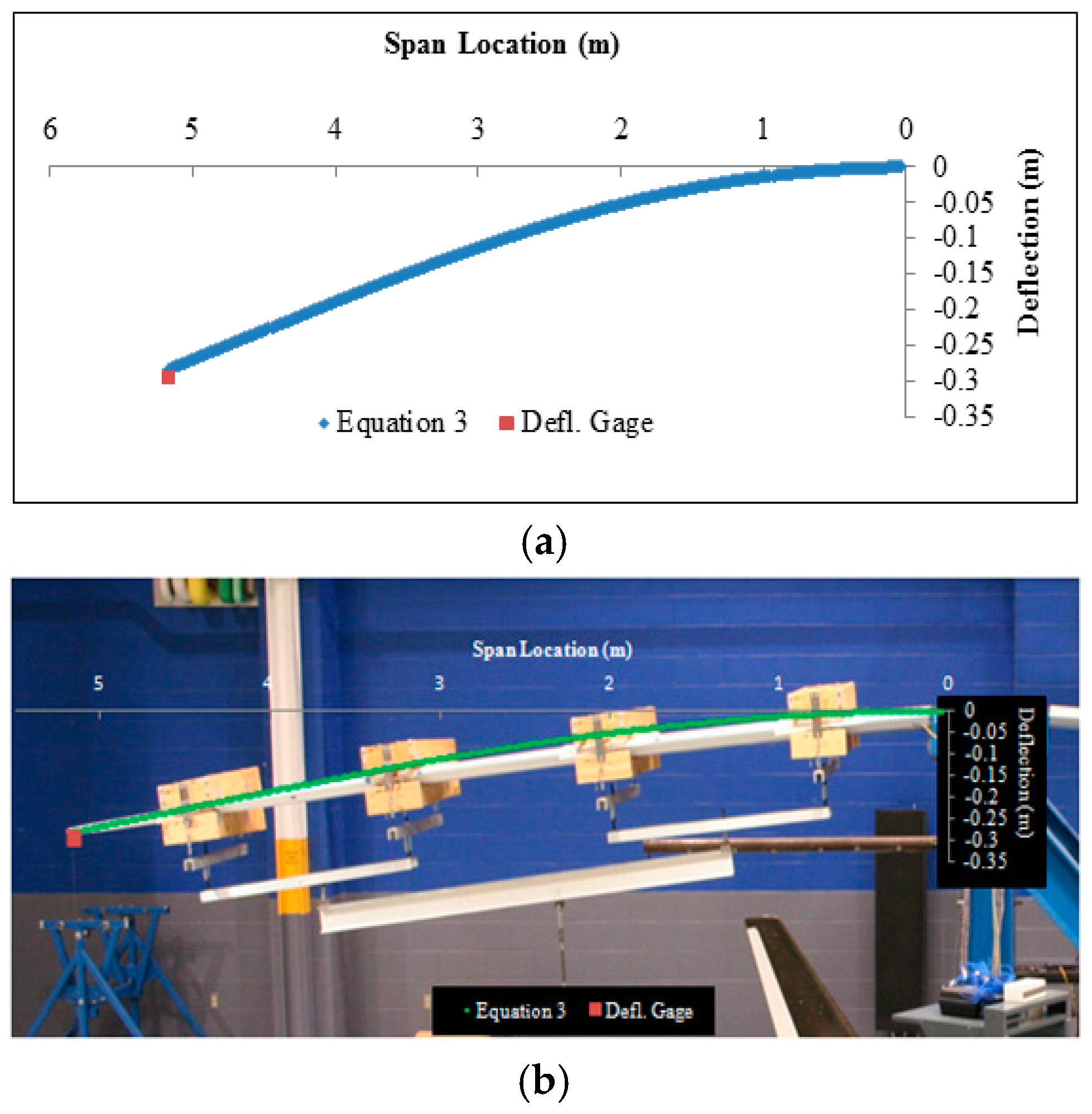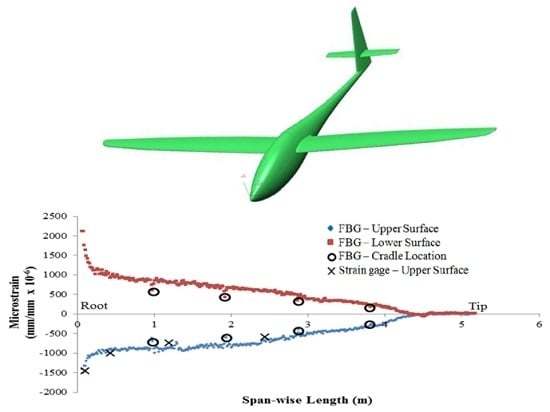3. FBG Monitoring of Large Scale Structures
FBG-based systems are enjoying wide usage in a number of industries and applications. The monitoring of structural performance to obtain loads and detect damage is increasingly gaining importance for many applications, particularly in the aerospace industry. Typically, load monitoring is accomplished by measuring local strains and damage detection involves the monitoring of acoustic signals [
15].
The widest use of FBGs is for measurement of strain, temperature, and pressure. Primarily, the shift in the wavelength or the refractive index is measured by the optical system and the strain ε is computed by Equation (2).
A number of studies deal with large aerospace vehicles and their components and most work involves the monitoring of strain data. The NASA Armstrong Flight Research Center (AFRC) has developed an instrumentation system and analysis techniques that combine to make distributed structural measurements practical for lightweight vehicles. AFRC’s fiber optic strain sensing (FOSS) technology enables a multitude of lightweight, distributed strain measurements [
4,
7,
16]. Motivated by the failure of the unmanned aerial vehicle (UAV) Helios, Richards et al. [
4,
17] used the spatial resolution and equal spacing of FBGs to monitor the real-time in-flight wing shape of the Ikhana and Global Observer UAVs. Alvarenga et al. [
18] also used FBGs on a lightweight UAV to determine the real-time deformation shape. A number of studies performed ground testing on aircraft and obtained measurements through FBGs mounted on the surface of the test structure. Childers et al. [
2] performed static loads tests on an advanced composite transport wing to obtain strain measurements from thousands of FBGs and compared these to measurements obtained from electrical foil gages. The high density of measurements revealed structural behavior that is typically obtained from numerical models. Kim et al. [
12] used a low speed, low cost FBG interrogator to obtain temperature compensated strain measurements of a full-scale small aircraft wing structure subjected to various temperatures and loading conditions. To develop a real-time UAV SHM system, Gupta et al. [
19] investigated a number of issues regarding FBGs such as sensor integration, location, and embedment. They used actual flight test data to monitor the vibration and loads signature during flight conditions. As a part of the European Smart Intelligent Aircraft Structures project, Ciminello et al. [
20] developed an in-flight shape monitoring system that uses the chord-wise strain distribution obtained from a network of FBG sensors for an adaptive trailing edge device.
FBG sensors can also be integrated into the test structure. Amano et al. [
21] embedded multiplexed-fiber FBG sensors into an aerospace carbon/epoxy advanced grid structure to measure mechanical strains of all ribs to evaluate damage under low-velocity impact loading. Dvorak et al. [
22] embedded FBG sensors into the carbon/epoxy spar caps and in the adhesive joints of a glass/epoxy composite wing to monitor strains during a static loads test. Ruzek et al. [
23] embedded FBGs in carbon-fiber reinforced plastic (CFRP) fuselage stiffened panels and performed compression after impact tests. The FBG-based system successfully acquired all buckling modes of the CFRP panels.
Other large scale applications include the work by Kim et al. [
10] in which FBG sensors were embedded in the adhesive layer joining the spar cap to the shear web of composite wind turbine blades to obtain deflection measurements. FBG-based systems have been used in the structural testing of composite overwrapped pressure vessels (COPVs). Banks et al. [
6] embedded FBGs to measure strain distributions in Kevlar COPVs during stress rupture tests. In-situ SHM was performed on filament wound pressure tanks subjected to water pressurization tests using embedded FBGs [
24]. Mizutani et al. [
25] conducted real-time strain measurements using FBG sensors on a composite liquid hydrogen tank mounted on a reusable rocket vehicle. In other transportation fields, such as the railway market, an FBG-based system has been developed and used on commercial railways to monitor hard and soft impacts on current collectors, enabling the detection of serious defects [
26]. In obtaining the strain responses of steel wires in a column support of a subway structure under ground motion, Chen et al. [
27] found that FBG sensors performed better than strain gages because the area is under large electromagnetic interferences. Wan et al. [
28] analyzed dynamic properties obtained from FBG data in the testing and monitoring of a large scale truss bridge.
FBGs have also been used for damage detection in large scale structures. In particular, carbon fiber polymer matrix composites are used in many advanced aerospace applications; this is primarily due to their high specific strength and stiffness in the fiber direction. However, even with modest loading, CFRPs develop complicated internal damage that can include matrix cracking, delaminations, and fiber breakage [
29]. Peña et al. [
30] used surface mounted and embedded FBGs in a COPV and developed a strain-measurement-based SHM parameter that can be used to track the COPV structural health throughout loading. Also, acoustic emission is often used as a non-destructive method for early detection of damage. Xiao et al. [
15] demonstrated the use of FBGs to simultaneously monitor both strains and acoustic signals for monitoring load and damage in aircraft structures. Mendoza et al. [
31,
32] reported on the development of a wireless in-flight FBG-based acoustic emission monitoring system known as FAESense™. The strain variations and AE signals were used to verify the occurrence and location of the damage. Betz et al. [
33] developed a damage identification system for aerospace structures that uses FBGs to sense ultrasound by obtaining the linear strain component produced by Lamb waves.
4. Determination of the Wing Shape and In-Flight Loads of an Ultralight Composite Wing
The carbon-composite multi-tapered wing of a sailplane-inspired aircraft (
Figure 2) was statically tested and strain measurements from FBGs were used to determine the out-of-plane deflections and loads [
7] using the FOSS system [
4,
16]. The wing was instrumented with two optical fibers along the main spar, one on the upper skin and one on the lower skin. These measurements were compared to four surface mounted strain gages and a displacement sensor. The wing assembly was subjected to distributed loads to simulate an in-flight maneuver using a three-tier whiffletree mechanism that was developed in a previous study [
34]. The resulting FBG strain measurements were compared to those obtained from conventional strain gages.
4.1. Description of Composite Wing
The composite wing has a semi-span of 5.5 m, a root chord dimension of 0.74 m, and a maximum airfoil thickness of 0.1 m at the root section.
Figure 3 shows the wing’s primary structures, which include the upper and lower skins, a root rib, a fore spar, an aft spar, and a main (center) spar. The main spar protrudes from the root rib to form the carry-through structure into the fuselage. The wing test article does not have aileron or spoiler cut-outs.
All structural components of the wing are fabricated from woven and unidirectional carbon-fiber/epoxy prepregs (Toray composites). The upper and lower skins are sandwich composites with a low density foam core (DIAB Divinycell
® HT50, Diab International AB, Helsingborg, Sweden) of thickness 3.175-mm; the engineering properties of the composite materials are given in
Table 1. The foam core extends over the wing surface to about 40-mm from the leading edge, trailing edge, and side boundaries. All structural components were fabricated separately and oven-cured before being adhesively bonded in an assembly jig. Steel lift pins were mounted to the root rib prior to final assembly to provide shear load transfer from the wing to the fuselage, as seen in
Figure 4. Further details regarding the wing structure can be found in Sullivan et al. [
34].
4.2. Experimental Setup and Procedure
The primary objective of this study was to use the high density of FBG strains to obtain the deflected wing shape and out-of-plane loads for a carbon composite wing subjected to distributed and concentrated loads. A universal test frame (UTF), shown in
Figure 5, was used as the support structure for all static test cases.
4.2.1. Wing Loading Methodology
A three-tier whiffletree system was used to simulate an in-flight lift distribution on the wing structure. As illustrated in
Figure 5, a saddle fixture that simulated the fuselage-wing connection region was used with the UTF to mount the inverted wing structure for testing. To transfer the load to each wing, four cradles were placed at the span-wise loading stations LS1, LS2, LS3, and LS4. The top and bottom of the cradles were designed to closely match the airfoil shape of the wing. Wood spacers of 25.4-mm thickness were placed under the upper cradles at the spar locations to avoid local damage to the wing skins. The composite wing was sandwiched between the top and bottom cradles to prevent slippage of the cradles and to minimize twisting of the wing during loading. The cradles were bolted together and attached to the first tier of the whiffletree using steel connectors. The second and third levels of the whiffletree consisted of aluminum C-channel sections and an aluminum I-beam, respectively. The load actuator was attached to a floor surface plate using a ball bearing to allow the actuator freedom of rotation during the loading process. The loading was applied by manual pumps that were connected to each actuator.
The loading sequence, consisting of thirteen loading increments included the weight of the wing, each cradle, each tier of the whiffletree, and the five load increments of approximately 222-N, for a total load on the wing of 2269-N, is given in
Table 2. After each loading increment, five sets of strain data from the FBG sensors and the strain gages were recorded and the averaged value was used in the calculation of the displacement and wing shape at each load.
Concentrated loads were applied to the wing at a distance of 4.3-m from the root rib, as shown in
Figure 6. These point loads were applied by placing lead weights into a container that was suspended from the center of gravity of the wing by a wooden cradle. Data was acquired after each load increment listed in
Table 3.
4.2.2. Wing Instrumentation
Two continuous optical fibers were affixed to the upper and lower surfaces of the left wing using MasterBond Supreme 33 (Hackensack, NJ, USA) adhesive. The FBG fibers, with a sensor spacing of approximately 12.5-mm, were placed from root to tip along the main spar, resulting in a total of 388 sensors on the upper surface and 390 sensors on the lower surface of the composite wing.
Figure 7a shows the location of the sensors on the wing structure. Four general-purpose strain gages (Vishay Measurements CEA-06-125UN-350, Micro-Measurements, Raleigh, NC, USA), with a nominal gage length of 3.175-mm, were installed along the main spar, next to the FBG fiber at the four gage stations GS0, GS1, GS2, and GS3, shown in
Figure 7a. The strain gages were placed approximately 12.7-mm from the optical fiber, as shown in
Figure 7b. In addition to the FBG sensors and strain gages on the surface of the left wing, both the right and left wings were instrumented with a tip displacement gage (Celesco PT1DC, Chatsworth, CA, USA). As shown in
Figure 5, a 50-kN load cell (Interface Advanced Force Measurement Model 1210BXV-50kN, Scottsdale, AZ, USA) was placed between the last tier of the whiffletree mechanism and the hydraulic loading cylinder.
LabVIEW
® [
35] software was used with a computer data acquisition system to obtain the strains and applied loads at each loading increment. Prior to loading the wings, the strain gages were balanced to a zero mean voltage by adjusting the output voltage from the strain gage amplifiers. Two channels (one for each surface mounted fiber on the wing structure) of an eight channel FOSS system were used to acquire the data from the 778 FBG sensors.
4.3. Out-of-Plane Displacements and Loads Algorithms
The deflection and load algorithms used in this study are based on classical beam theory. It is to be noted that the loading of the composite wing was applied in a manner to minimize all twist, thereby considering only the case of pure bending.
4.3.1. Out-of-Plane Displacements Algorithm
Utilizing the surface strain measurements at multiple equally spaced sensing stations the displacement equation can be expressed using discrete strain measurements as [
36,
37]:
where
y is the deflection at the strain sensing station
i,
ΔL is the spacing between strain sensing stations,
c is the distance from the neutral axis to the outermost surface, and
ε is the strain measured at the
ith FBG. For demonstration,
Figure 8 shows the elastic curve of a tip loaded cantilevered beam from classical beam theory and from using Equation (3); using only nine stations (
n = 9), excellent agreement is obtained.
4.3.2. Out-of-Plane Loads Algorithm
The loads algorithm, which was used to determine the out-of-plane loads from the in-plane FBG strains, was originally developed by Richards et al. [
38] from the classical beam equation for a prismatic beam and later validated by Bakalyar and Jutte [
16] on flat monolithic plates. In the present study, the loads algorithm was used for the first time to determine the out-of-plane loads of an air vehicle structure. For completeness, a brief development of the algorithm is given. The bending moment can be written in terms of each FBG strain sensor location
i as:
where
Mi is the bending moment, ε
i is the strain, (
EI)i is the flexural rigidity, and
c is the distance from the neutral axis to the sensor. The moment at each station
i can also be determined by taking the moment at each longitudinal location (
L − i∆L) using:
and
P is the applied load. Using Equation (5) in Equation (4), the flexural rigidity
(EI)i at each FBG station is obtained as:
where
L is the length of the beam,
i is the sensor station number (
i = 1, 2, ···,
n),
∆L is the spacing between strain sensors,
c is the distance from the neutral axis, and
ε is the strain at the
ith station. Equation (6) is used to determine the flexural rigidity of a cantilevered beam by obtaining the strain response for a concentrated load at a known location. The flexural rigidity can be used in Equation (4) to determine the bending moment, which is subsequently used to calculate the shear loads
Vi from:
where
xi is the FBG strain sensor locations. The out-of-plane loads
Pi are determined using the equilibrium of forces, as:
4.4. Results and Discussion
Strain measurements from 778 FBG sensors were used to compute the wing shape and the out-of-plane load per sensor for the concentrated and distributed loading cases. Concentrated loading was used primarily to enable the calculation of the flexural rigidity of the complex wing at each sensor location for subsequent use in the determination of the out-of-plane loads for all test cases. The composite wing was subjected to a distributed loading to simulate an in-flight loading condition.
4.4.1. Concentrated Loading
At each of the 778 FBG sensor locations, the flexural rigidity of the wing section was determined (Equation (6)) and the values computed from each load increment were averaged to obtain the effective flexural rigidity. The strain from the largest concentrated load (468-N) and the effective flexural rigidity (
EI)i were used in Equation (4) to determine the bending moment
Mi. A linear regression fit of the bending moment data was performed and the results were used to calculate the shear force distribution and subsequently the out-of-plane loads using Equation (8).
Table 4 shows the results of the load calculation for an applied load of 468-N; the total computed load is within 1.62% of the applied load. The computed out-of-plane loads for each of the load increments, with one exception, are within 2% of the applied load, as shown in
Table 5.
4.4.2. Strains under Distributed Loading
Figure 9 shows the measured strain distribution from the FBG sensors and the strain gages at the maximum resultant load of 2269-N. The measured strains from the strain gages are slightly offset from those obtained from the FBGs; this was expected since the strain gages could not be placed directly on the FBGs and were actually mounted approximately 13-mm from the optical fiber (
Figure 7b).
Figure 9 shows a generally linear strain distribution along the wing span. Elevated strains are seen close to the wing root, where the load rapidly transitions to the main spar. The high spatial density of the strains from the FBGs also revealed some physical details not normally obtained from conventional strain gages. For example, the locations designated by the open circles in
Figure 9 were determined to be locations directly under the cradles.
4.4.3. Deflections under Distributed Loading
The measured FBG strains were used to determine the elastic deflection curve. The wing shape at a resultant whiffletree load of 2269-N (2.27-g) is shown in
Figure 10a; for demonstration, the computed elastic curve is superimposed on the deflected wing in
Figure 10b. At this loading, the left wing tip deflection was measured to be 0.295-m, resulting in a 3.75% difference from the computed deflection of 0.284-m.
Table 6 shows the calculated deflections for several load cases, and the predictions are within 4.2% of the measured data.
4.4.4. Out-of-Plane Loads under Distributed Loading
The in-plane FBG strain data obtained from the whiffletree (distributed) loading was used to determine the out-of-plane loads. The effective flexural rigidity, determined from the concentrated load case, was used to calculate the bending moment acting on the wing. A third-order polynomial regression was used to obtain the moment as a function of the span-wise location; this was subsequently used to calculate the out-of-plane load per sensor, as shown in
Figure 11.
Table 7 shows that the computed FBG-based loads are within 4.2% of the measured applied loads.
5. Conclusions
This paper provides an overview of FBG-based sensing for large scale applications, demonstrating the real-world applications and increasing usage of optical fiber measurement methods. These sensors are being used in every industry, particularly for aerospace and civil structures, for measurement and monitoring of strains, temperatures and pressures and for detecting damage. The many attributes of FBG sensors make them ideal for measurement and monitoring applications.
For demonstration of an operational application, a fiber optic strain sensing system was used to obtain a strain distribution over the semi-span of a full scale composite wing subjected to concentrated and distributed loads. The high spatial resolution of the FBG strain measurements enabled the computation of the deflected wing shape and out-of-plane loads of the wing. When compared to conventional foil strain gages, the FOSS system provided a much higher density (every 12.5-mm) of strain measurements, thereby revealing details of the structure under load.

